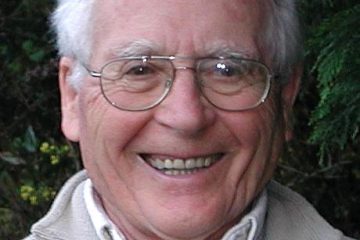Table of Contents
- Understanding James Lovelocks Contributions to Earth Sciences
- Exploring the Gaia Theory and Its Impact on Environmental Thought
- The Life and Achievements of James Lovelock: A Biographical Overview
- Relevance of Lovelocks Ideas in Todays Climate Discussions
- Practical Applications of Gaia Theory in Sustainability Practices
- Q&A
- Key Takeaways

Understanding James Lovelocks Contributions to Earth Sciences
James Lovelock, a pivotal figure in earth sciences, is best known for his development of the Gaia Hypothesis. This groundbreaking concept proposes that the Earth operates as a self-regulating entity where biotic and abiotic components interact in a complex web, maintaining the conditions necessary for life. Lovelock’s work suggests that living organisms influence their environment, which in turn affects the organisms themselves. This dynamic interrelationship challenges the traditional view that the Earth is a mere backdrop to the biological processes occurring on its surface.
Beyond the Gaia Hypothesis, Lovelock has made significant strides in analytical chemistry, particularly in his work on environmental monitoring. He invented the electron capture detector, a sensitive device that revolutionized the detection of trace gases in the atmosphere. This innovation has had far-reaching implications for understanding climate change, air quality, and the presence of pollutants. His emphasis on the role of human activity in altering Earth’s systems has catalyzed discussions on sustainability and environmental stewardship.
Lovelock’s contributions extend into public discourse, where he has championed the understanding of climate change and its consequences. Through his writings and speeches, he has emphasized the urgency of addressing environmental issues. His advocacy for the adoption of renewable energy sources, alongside his cautionary tales about the dangers of complacency, resonate in contemporary climate dialogues. By combining scientific rigor with passionate advocacy, Lovelock has ignited conversations that bridge the gaps between science, policy, and public awareness.

Exploring the Gaia Theory and Its Impact on Environmental Thought
The Gaia Theory, conceived by James Lovelock, posits that the Earth functions as a self-regulating, complex system where living organisms interact with their inorganic surroundings to maintain conditions suitable for life. This revolutionary idea highlights the interconnectedness of all life forms and ecosystems, suggesting that the biosphere and the atmosphere work in harmony to sustain its continuous balance. By viewing the planet as a single, living entity, the theory invites us to reconsider our relationship with the environment and emphasizes the necessity of nurturing our planet, rather than exploiting it.
One of the profound impacts of Gaia Theory on environmental thought lies in its challenge to conventional views of nature. It shifts the narrative from viewing the Earth merely as a commodity to be used for human benefit, to recognizing it as a vital, interdependent organism. This perspective encourages the adoption of sustainable practices and a more ethical approach to environmental stewardship. Major concepts influenced by this theory include:
- Ecological Responsibility: Understanding the consequences of our actions on global ecosystems.
- Climate Change Awareness: Recognizing human activity’s role in altering the Earth’s natural systems.
- Interconnectedness: Valuing biodiversity and its essential role in maintaining ecological balance.
Moreover, the Gaia Theory has inspired various movements and initiatives advocating for environmental protection. Contemporary environmentalism often draws from Lovelock’s insights, promoting policies that prioritize ecological health as a foundation for human survival. Educational programs have emerged, emphasizing an integrated approach to science and conservation, fostering a deeper awareness of how our choices impact the planet. Recognizing that every action contributes to the larger system can empower individuals and communities to engage in more conscious, sustainable behaviors.

The Life and Achievements of James Lovelock: A Biographical Overview
James Lovelock, born on July 26, 1919, in Letchworth, Hertfordshire, is best known for his pioneering work in environmental science and his development of the Gaia theory. This revolutionary hypothesis posits that the Earth functions as a self-regulating system, where living organisms interact with their inorganic surroundings to maintain conditions conducive to life. Lovelock’s scientific journey began with a strong foundation in chemistry, which later evolved into a diverse exploration of atmospheric science, biochemistry, and even planetary science.
Throughout his career, Lovelock contributed significantly to various fields, culminating in several notable achievements:
- Development of the Gaia Hypothesis: Introduced in 1972, this theory has reshaped the way we understand the relationship between life and the Earth.
- Invention of the Electron Capture Detector (ECD): This crucial device helped detect trace gases in the atmosphere, advancing the field of environmental monitoring.
- Authorship of Influential Books: Titles such as ”Gaia: A New Look at Life on Earth” have brought complex scientific ideas to broader audiences, inspiring environmental awareness.
In recognition of his contributions, Lovelock has received numerous honors and accolades. His work has not only opened new pathways in environmental research but also ignited global conversations about climate change and sustainability. Lovelock’s insights have encouraged a deeper understanding of the interconnectedness of life and the planet, reinforcing the urgent need for humanity to coexist harmoniously with nature.
Relevance of Lovelocks Ideas in Todays Climate Discussions
James Lovelock’s contributions to environmental science resonate powerfully in contemporary climate discourse. His Gaia Theory, which posits that the Earth functions as a self-regulating system, underscores the intricate interdependencies within our biosphere. Understanding this holistic view is crucial as we tackle pressing issues like climate change, highlighting the need for collaboration between humans and natural systems. By adhering to Lovelock’s principles, society can foster a deeper appreciation for biodiversity and ecosystem health, motivating proactive measures to combat environmental degradation.
Furthermore, Lovelock’s emphasis on the importance of adaptation over mere mitigation has become increasingly relevant. As climate impacts intensify, the ability to adapt to changing conditions—such as rising sea levels, extreme weather, and resource scarcity—is vital. His call for innovative solutions, including embracing renewable energy sources and sustainable practices, advocates for a multifaceted approach to environmental challenges. This perspective encourages both individuals and governments to not only respond to climate crises but to anticipate them, preparing society for a more resilient future.
In the context of modern climate discussions, Lovelock’s insights encourage a shift in narrative towards a more integrated perspective on environmental stewardship. Policymakers and activists increasingly recognize the need to weave ecological considerations into economic frameworks and urban planning. As we face the looming threats of ecological collapse, fostering public awareness around these ideas is essential. Educational initiatives that draw from Lovelock’s work can empower communities to advocate for sustainable policies, illustrating the critical link between ecological health and human well-being.

Practical Applications of Gaia Theory in Sustainability Practices
Gaia Theory, conceptualized by James Lovelock, posits that the Earth functions as a self-regulating system, where biological and physical components interact to maintain conditions conducive to life. This perspective has profound implications for sustainability practices, encouraging a holistic view that integrates ecological, social, and economic dimensions. By adopting this viewpoint, organizations can foster strategies that not only address environmental concerns but also promote community resilience and economic viability.
One practical application of Gaia Theory in sustainability is the use of permaculture, a design system that mimics natural ecosystems to cultivate food, energy, and waste. Farmers and gardeners utilize principles derived from Gaia Theory to create agricultural systems that enhance biodiversity, conserve water, and improve soil health. This not only meets human needs but also supports the ecosystem by:
- Reducing pesticide and herbicide use
- Encouraging local wildlife
- Implementing crop rotation and polyculture techniques
Moreover, organizations can adopt circular economy principles grounded in Gaia Theory to create closed-loop systems that minimize waste. By prioritizing resource efficiency and supporting systems that reuse materials, businesses can reduce their ecological footprint while still meeting consumer demands. A comparison of traditional linear economies versus circular economies illustrates the difference in sustainability approaches:
| Traditional Economy | Circular Economy |
|---|---|
| Extract, produce, dispose | Reduce, reuse, recycle |
| Generates waste | Aims for zero waste |
| Short-term resource use | Long-term sustainability |



0 Comments